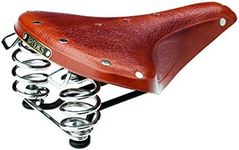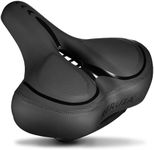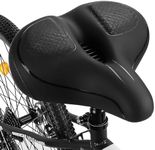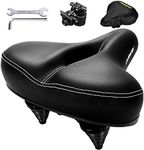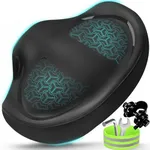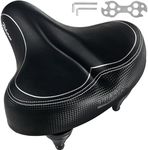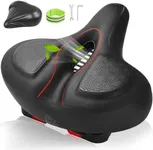Buying Guide for the Best Bike Seat For Women With Big Butts
Choosing the right bike seat is crucial for comfort, especially if you plan to ride often or for long distances. For women with wider hips or larger buttocks, a well-fitted seat can make all the difference in preventing discomfort, numbness, or even injury. The key is to find a seat that supports your sit bones properly, reduces pressure on sensitive areas, and matches your riding style. Understanding the main features of bike seats will help you make a choice that keeps you comfortable and happy on every ride.Seat WidthSeat width refers to how wide the saddle is at its broadest point. This is important because it needs to support your sit bones, which are the bony parts of your pelvis that bear your weight when you sit. For women with wider hips or larger buttocks, a wider seat is usually more comfortable because it provides better support and prevents the seat from digging in. Seat widths can range from narrow (less than 140mm), medium (140-160mm), to wide (over 160mm). If you have a larger build, look for seats in the wide category, but make sure it’s not so wide that it causes chafing or restricts your pedaling. The best way to pick is to measure the distance between your sit bones and choose a seat that matches or slightly exceeds that width.
PaddingPadding is the soft material on top of the seat that cushions your ride. It’s important because it absorbs shocks and reduces pressure on sensitive areas. Padding can range from minimal (for performance or racing seats), moderate (for general use), to plush (for comfort or cruiser seats). If you’re looking for comfort and have a larger butt, a seat with moderate to plush padding is usually best. However, too much padding can sometimes cause discomfort on longer rides, as it may compress and create pressure points. Think about how long and how often you ride: for short, casual rides, more padding is fine; for longer rides, moderate padding with good support is better.
Seat ShapeThe shape of the seat affects how it fits your body and how comfortable it feels. Some seats are flat, while others are curved or have a dip in the middle. Wider, more contoured seats are generally better for larger buttocks because they distribute weight more evenly and reduce pressure. Look for seats labeled as 'ergonomic' or 'anatomic,' as these are designed to fit the natural curves of your body. If you ride upright (like on a cruiser or city bike), a wider, more rounded seat is ideal. For more aggressive, forward-leaning positions (like on a road bike), a slightly narrower, contoured seat may be better.
Cutouts and Relief ChannelsCutouts and relief channels are grooves or holes in the middle of the seat. They are important because they reduce pressure on sensitive soft tissue areas, which can help prevent numbness and discomfort, especially for women. Seats with a central cutout or channel are a good choice if you experience pressure or numbness when riding. The size and shape of the cutout can vary, so try different styles to see what feels best for you. If you don’t have issues with pressure, a solid seat may be fine, but many people find relief channels more comfortable for longer rides.
Cover MaterialThe cover material is what you sit on, and it affects both comfort and durability. Common materials include synthetic leather, real leather, and fabric. Synthetic covers are usually more weather-resistant and easier to clean, while real leather can mold to your shape over time but requires more care. Fabric covers can be softer but may wear out faster. If you ride in all weather or want low maintenance, synthetic is a good choice. If you want a seat that gets more comfortable with age and don’t mind some upkeep, leather is an option.
Suspension and SpringsSome bike seats have built-in suspension or springs under the seat to absorb bumps and vibrations. This is especially important if you ride on rough roads or trails, as it can make your ride much smoother. Seats with springs are usually found on comfort or cruiser bikes and are a good choice if you prioritize comfort over performance. If you mostly ride on smooth pavement, you may not need this feature, but for bumpy rides, it can be a big help.
